Timing is everything when transplanting seedlings.
Ideally, you want to get them planted outdoors just after the last frost of winter, but not so early that they fail to adapt to the outdoor climate.
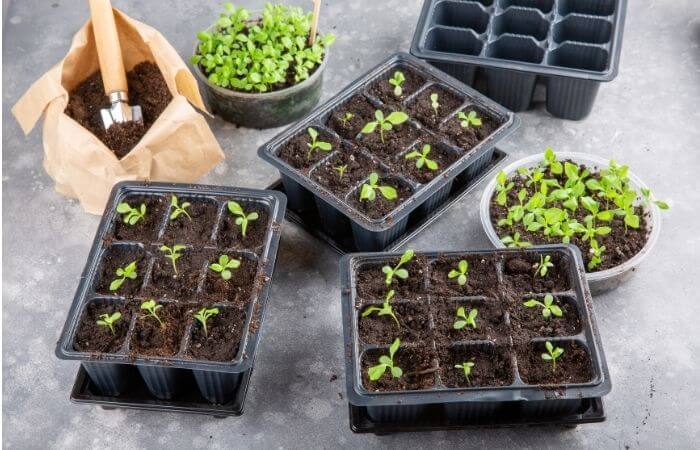
Transplanting seedlings at the wrong time may cause them to die and ruin your work and your hopes of a lush garden come summer.
To prevent problems, read the details below about the ins and outs of seedling growth and how to transplant them the right way so your garden can be the envy of the neighborhood!
How Big Should Seedlings Be Before Transplanting?
It’s not the seedling size that determines when you should transplant it, but the stage of growth it achieves.
Experienced gardeners find that waiting until your seedlings have four real leaves will ensure the plant is hearty enough to withstand the stress of transplanting.
Remember that the first two leaves appear on any plant are called cotyledons, and these are not true leaves.
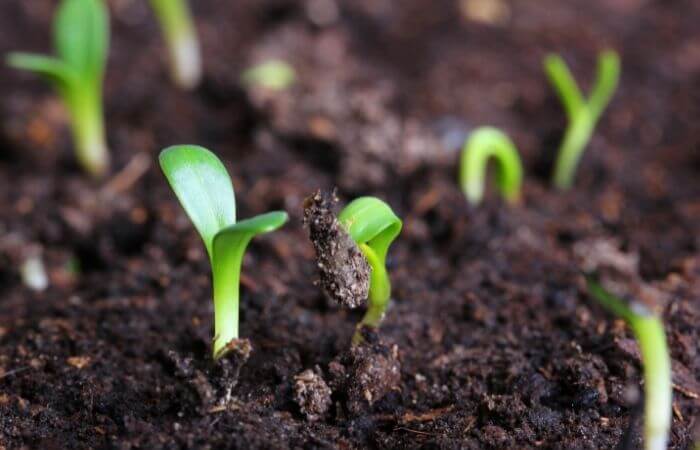
The cotyledon is part of a seed’s embryonic system and will sprout along with the root to provide food and energy for the growing plant.
The leaves that appear after the cotyledon are the ones you need to count. While having more than four leaves is fine for transplanting, never rush to move seedlings with fewer than four into larger pots or your garden, no matter how warm it is outside.
Transplanting Seedlings Too Early
When you transplant seedlings too early, you risk:
- Death to the plant from damage to the delicate root system
- Shock to the plant from not giving them time to harden off before transplant
- Die-off from the soil being too cold
- Die-off from unexpected frost or cold nights
There is no reason to rush seedling transplants, as doing so can destroy all your hours of hard work planting trays and growing your seeds.
Patience is crucial at this gardening stage if you want to give all your seedlings a fighting chance in their new home.
How Long Does Seedling Stage Last?
In most plants, the seedling stage will last 14-21 days. A few plants will grow their four leaves faster, and others can take up to six weeks.
As long as your plant looks firm, green, and happy, the only thing you can do is watch and wait for the leaves to emerge.
Once the seedlings get enough leaves, it moves on to the vegetative or “veg” stage, where growth quickens, so this is the time to move them to a larger pot or outdoors.
When To Transplant Seedlings To Bigger Pots
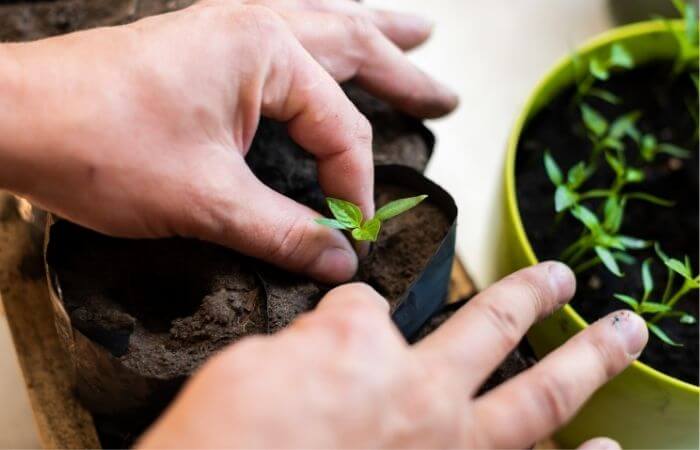
Moving a seedling to a bigger pot doesn’t need to happen as soon as a plant gets four real leaves. The size of the original planting container will determine the best time to transplant.
The key to healthy mature plants is to make sure seedlings have room for unrestricted root growth as they move into the veg stage.
Next, we look at the most typical seedling starter containers and explain when you should transplant your plants out of them to keep them thriving.
When To Transplant Seedlings From Seed Tray
Seed trays can come in many different cell sizes, but even the largest will not hold your seedling for long.
If your tray’s cells are tiny, you can expect to transplant them into a bigger pot as soon as you see those first four leaves, as, by that time, the root system has probably spread to maximum size in the space it has.
For larger cells, say three-by-three inches across, you can wait for five or six weeks on average.
A good test is to slide out one plant and scrutinize the root growth.
If you see slight amounts of root hairs around the perimeter of the soil, the time is right to transplant to a larger pot in the next few days.
If the roots are dense around the soil’s outer edge, it’s been in the seedling tray too long, so move it to a bigger pot immediately.
When To Transplant Seedlings From Solo Cup
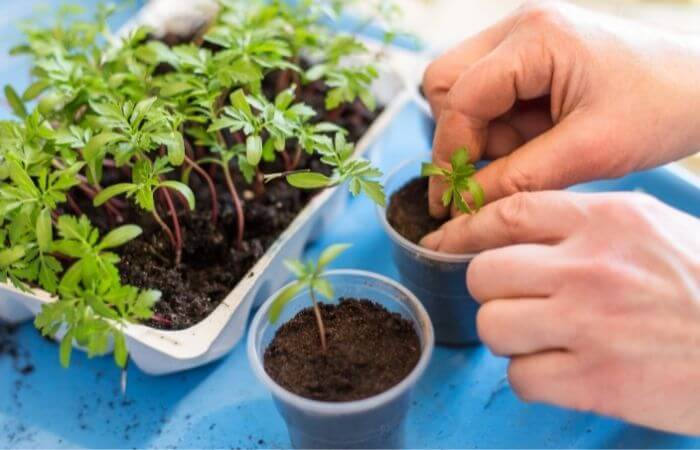
Solo cups make great seedling vessels as they are spacious enough for good plant development before needing to transplant them to a larger container.
The best way to know when it’s time to transplant seedlings from a solo cup is when the foliage grows out to cover the edges of the cup.
Letting the plant grow larger will also mean the roots will start to circle inside the base of the cup, which will hinder its future growth.
How Long Can Seedlings Stay In Peat Pellets?
For gardeners who use peat pellets or coir cubes to start seeds, a great indication it’s time to transplant into a more substantial container is when you see the roots emerge from the medium.
At this stage, the roots will need soil to hold the plant stable as it continues to grow.
Another reason you need to move seedlings out of peat pellets is that they provide no nutrients. Potting them into a rich soil full of organic matter will give the roots plenty of nutrition and moisture so the plant can thrive.
When To Move Seedlings Outside
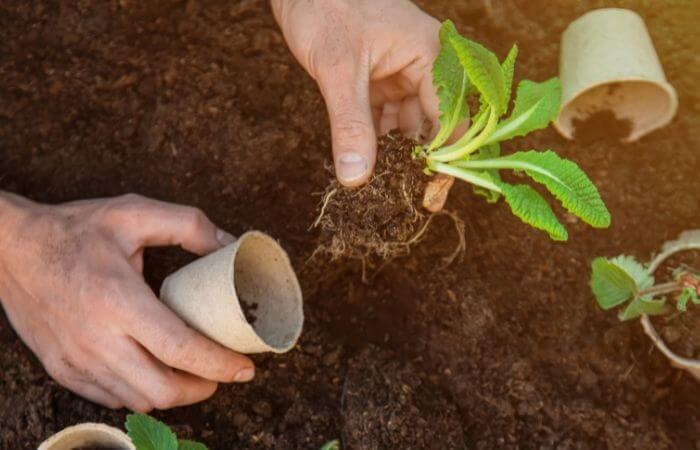
You can safely move seedlings outside after the last frost for your region for cold-hardy crops or most vegetables or flowers when nighttime temperatures stay above 50 degrees.
You can also wait until the soil temperature has hit a minimum of 60-degrees, which you can check with a soil thermometer.
Always harden off your seedlings before transplanting them outside, as they need to condition themselves to the new environment slowly. If you plant seedlings directly from a greenhouse or inside your home, the shock could kill your plants.
To transplant your seedlings the right way, reduce fertilizer and water the last two weeks they will be indoors to get them adjusted to life in the garden.
During the last week before transplant, place your seedlings outdoors in a shady location during the late morning for a few hours to allow them to adjust to more sunlight exposure slowly.
Bring them back in overnight, and repeat daily. Gradually move the seedlings into a sunnier location each time you bring them outside.
Watch the seedlings closely for signs of overexposure or dryness such as drooping or yellowing and either move the plants back into the shade or give them water.
Once you transplant seedlings outdoors, pay attention to the overnight weather. If you see a cold snap heading your way, protect your plants by draping them with a layer of fabric to keep them safe, then remove the material in the morning.
In Summary
Treating seedlings right will give them the best start in life. Knowing when and how to transplant seedlings from any plant-starting container can make a difference between a vibrant garden and one that fails.
Transplanting seedlings at the right time will allow them to thrive and grow outdoors into stunning flowers or abundant vegetable garden, so use the information above to get a head start on a successful gardening season!










